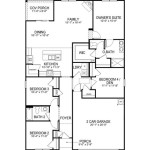How to Plan a Home Remodel
Embarking on a home remodel is a significant undertaking that requires meticulous planning and execution. A successful remodel can enhance property value, improve functionality, and revitalize living spaces. However, without a well-defined plan, the project can quickly become overwhelming, leading to cost overruns, delays, and dissatisfaction.
Effective planning is paramount to ensuring a smooth and successful home remodel. This involves careful consideration of needs, budget allocation, design choices, contractor selection, and project timelines. Addressing these aspects proactively will minimize potential challenges and maximize the return on investment.
Defining Project Scope and Objectives
The first step in planning a home remodel is to clearly define the project's scope and objectives. This involves identifying the rooms or areas to be remodeled, the specific changes to be made, and the desired outcomes. A comprehensive understanding of these elements will guide subsequent decisions and ensure that the remodel aligns with the homeowners' needs and preferences.
Begin by conducting a thorough assessment of the current state of the home. Identify areas that are functionally inadequate, aesthetically unappealing, or in need of repair. Consider how the remodel can address these issues and improve the overall living experience. For example, a kitchen remodel might focus on improving storage, enhancing workflow, and updating appliances.
Prioritize remodel goals based on importance and feasibility. Distinguish between essential improvements and desirable enhancements. This prioritization will help in allocating resources effectively and making informed decisions when faced with budget constraints or unforeseen challenges.
Create a detailed list of specific tasks and modifications to be included in the remodel. This list should be as comprehensive as possible, encompassing everything from structural changes to cosmetic upgrades. For instance, it might include tasks such as relocating walls, installing new flooring, replacing fixtures, and painting surfaces.
Consider the impact of the remodel on the overall flow and functionality of the home. Ensure that the changes integrate seamlessly with existing spaces and enhance the overall living environment. For example, when remodeling a bathroom, consider its proximity to bedrooms and other living areas to optimize convenience and accessibility.
Document the existing conditions of the areas to be remodeled, including photographs, measurements, and notes. This documentation will serve as a valuable reference point throughout the project and facilitate communication with contractors and designers.
Establishing a Realistic Budget and Financing Options
Establishing a realistic budget is a crucial component of home remodel planning. It involves estimating the costs associated with all aspects of the project, including materials, labor, permits, and contingencies. A well-defined budget provides a framework for financial decision-making and helps prevent cost overruns.
Research the average costs of similar remodel projects in the local area. This research will provide a benchmark for estimating the overall cost of the project. Online resources, home improvement publications, and consultations with contractors can provide valuable insights into current pricing trends.
Obtain detailed quotes from multiple contractors for the various aspects of the remodel, such as demolition, construction, plumbing, electrical, and painting. Compare the quotes carefully, considering both price and quality of service. Ensure that the quotes clearly outline the scope of work and the materials to be used.
Allocate a contingency fund to cover unexpected expenses or unforeseen challenges that may arise during the remodel. A general rule of thumb is to set aside 10-20% of the total budget for contingencies. This fund will provide a financial safety net and help prevent the project from derailing due to unforeseen circumstances.
Explore various financing options to fund the remodel, such as home equity loans, personal loans, and credit cards. Evaluate the interest rates, repayment terms, and associated fees of each option to determine the most suitable financing solution. Consider the long-term financial implications of each option and choose the one that aligns with the homeowners' financial goals.
Create a detailed budget breakdown that itemizes all anticipated expenses, including materials, labor, permits, and contingencies. Track expenses meticulously throughout the project and compare them to the budget to identify any discrepancies or potential cost overruns. Adjust the budget as needed to reflect any changes to the project scope or unforeseen expenses.
Consider the potential return on investment (ROI) of the remodel. Certain improvements, such as kitchen and bathroom remodels, typically offer a higher ROI than others. Prioritize projects that are likely to increase the home's value and appeal to potential buyers.
Selecting Qualified Contractors and Obtaining Permits
Selecting qualified contractors is essential for ensuring the successful completion of a home remodel. A skilled and experienced contractor can provide valuable guidance, manage the project effectively, and deliver high-quality workmanship. Thorough vetting and careful selection are crucial to mitigating risks and achieving desired outcomes.
Obtain recommendations from friends, family, neighbors, and online reviews. Seek out contractors who have a proven track record of successful remodel projects in the local area. Verify that the contractors are licensed, insured, and bonded, as required by local regulations. This verification will protect the homeowner from liability in case of accidents or damages during the project.
Interview multiple contractors and ask about their experience, qualifications, and approach to home remodeling. Request references from previous clients and contact them to inquire about their experiences working with the contractor. Inquire about the contractor's project management processes, communication methods, and warranty policies.
Review the contractor's portfolio of past projects to assess the quality of their workmanship and design style. Ensure that the contractor's style aligns with the homeowner's preferences and that they are capable of executing the desired design. Request a detailed proposal that outlines the scope of work, materials to be used, project timeline, and payment schedule.
Carefully review the contract before signing it. Ensure that all terms and conditions are clearly defined, including the scope of work, payment schedule, change order process, and dispute resolution mechanisms. Consult with an attorney if necessary to ensure that the contract protects the homeowner's interests.
Obtain all necessary permits before commencing the remodel. Building permits are typically required for structural changes, electrical work, plumbing work, and other significant modifications. Contact the local building department to determine the specific permit requirements for the project. Failure to obtain the necessary permits can result in fines, delays, and potential legal issues.
Work closely with the contractor throughout the remodel to ensure that the project progresses according to plan. Communicate regularly and address any concerns or questions promptly. Monitor the quality of workmanship and ensure that the contractor adheres to building codes and safety standards.
Establish a clear process for change orders. Change orders are written agreements that document any changes to the original scope of work and the associated costs. Ensure that all change orders are documented and approved in writing before the work is performed. This will prevent misunderstandings and ensure that the homeowner is aware of any additional costs.
Conduct regular site visits to monitor progress and address any issues that may arise. Maintain open communication with the contractor and provide feedback as needed. Document all communications and decisions in writing to avoid misunderstandings.
Upon completion of the remodel, conduct a final inspection to ensure that all work has been completed to the homeowner's satisfaction. Create a punch list of any remaining items or deficiencies that need to be addressed. Ensure that the contractor provides warranties for all work performed and materials used.
Gather all relevant documentation, including permits, contracts, warranties, and appliance manuals. Store these documents in a safe and accessible location for future reference. This documentation will be valuable for future maintenance, repairs, and potential resale of the home.

The Ultimate Home Renovation Guide Budget Dumpster

5 Stages Of Remodeling

The Ultimate Home Renovation Guide Budget Dumpster

Create A Home Remodeling Plan In 10 Simple Steps Hometown Demolition

How To Plan A Home Remodel Step By Tips For Designing Renovation Increase Value

These Are The 10 Steps To A Great Home Remodel Plan Element Remodeling

The Ultimate Home Renovation Guide Budget Dumpster

Home Renovation Planner Plan Template Printable Checklist Improvement Budget House Remodel

Crafting Your Dream Home Phased Remodeling With A Master Plan Design Lines

Here S How To Plan A Whole Home Remodel








